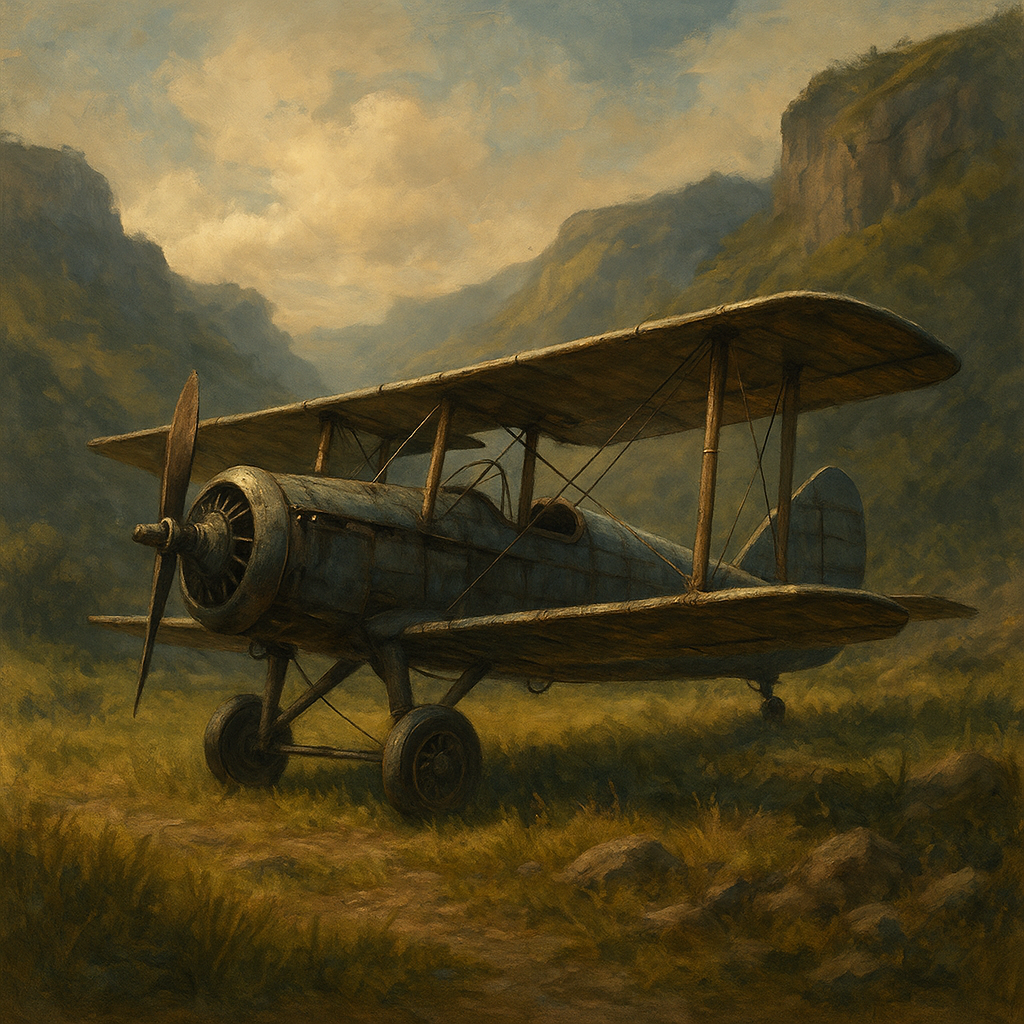Aeroplanes
"We flew. Gods forgive us, we flew. And then Vile saw us do it."
In the waning years of The Lost Ages, when faith in progress dared to rival fear of the unknown, a miracle of iron and air was born. A collaboration between the Dwarfish tinkerer Holgrim and his Canid artificer counterpart, Reman Roarke, the aeroplane, known colloquially as the Ironbird, was born. A feat thought impossible even by seasoned inventors. Where carts once crawled and trains thundered across wooden rails, this machine took to the skies themselves where none but beast had gone before. For a brief time, Gaiatia dreamed skyward. Passengers, post, and artillery alike were envisioned to ride the wind. But the dream was short-lived. With the coming of The Fall and The Great Schism's woesome savagery that followed soon-after, not only did airfields burn that once housed them, but so too did the blueprints, engineers, and infrastructure required to sustain them. The devil Vile, and his armies that laid siege to the world of old, ripped flight from our hands before we could ever nest in it. Now, only reverent stories and trembling hands keep their memory alive, what few aeroplanes remain unbroken are worshipped as relics; Ritualistically oiled, prayed over, and flown only in the direst of times, their bones aching with every revolution.
Utility
Originally created as a military courier and recon craft, the aeroplane's success spawned dreams of cargo transport, sky-trade, and even aerial combat vessels. Naval hybridization, floating fortresses, and airborne colonies were beginning to be imagined before the Fall. Misuses were tragic and immediate: espionage flights gone awry, smuggling operations defying border treaties, and experimental flame-droppers used in unsanctioned border wars between pre-Schism factions. One crashed during a test run, igniting half the valley. Another allegedly made it from Kathar, to poetically, considering it's Dwarfish origins and their similar exodus, all the way to The Cloudrend Mountains where their race would settle after the Schism nearly two centuries later...
Manufacturing
Aeroplanes were never mass-produced. The original models were hand-built in artisan workshops, with assistance from engineer and artificer guilds.
- Rare elemental alloys and blast-forged panels.
- Alchemical adhesives.
- Specialized airship hangars, often carved into cliffsides.
- Machine-tempered parts and forged fittings only replicable with Lost Age forges.
Social Impact
For a few fleeting years, the sky belonged to mortals. Farmers saw iron shadows overhead. Clerics declared the heavens breached. Children called the roar of the engine the Voice of Thunderbirds. But now? Now the aeroplane is a ghost, a testament to ambition, and a symbol of everything lost. Scholars revere it. Peasants fear it. Military factions hunger for it, but dare not ask openly. It is one of the clearest examples of just how far civilization fell, and how fragile the bridge between ingenuity and annihilation truly is. The knowledge of flight lingers as a scar on Everwealth’s memory. For some, it inspires hope. For others, it breeds resentment. A device that once promised unity now divides myth from truth, memory from reality.
Access & Availability
Aeroplanes are now nigh-mythical in their scarcity. At most, a dozen incomplete or non-functioning models are rumored to remain, scattered across royal vaults, ruined airfields, or preserved by guild-backed tinkerers too old or superstitious to recreate them. The machines are not publicly used, their maintenance forbidden by the Arcane Coalition save for in wartime or extraordinary circumstance. Flying one is an act of desperation, or divine necessity. Crashes are common. Replacement parts are relics themselves. The act of re-flight is treated as holy, heretical, or both, depending on who witnesses it.
Complexity
The aeroplane’s internal workings are a masterpiece of pre-Schism ingenuity, combining combustion-based thrust with alchemical stabilizers and mechanical lift. It requires:
- A combustion engine powered by refined oil or substituted pyrefuel.
- Reinforced ironwood frames for structural support.
- Magicked rivets or shock-hardened welds.
- A navigational system akin to early automaton cores.
- Trained pilots, often initiated into guilds for knowledge preservation.
Discovery
The first aeroplane was completed just 43 years before The Fall, after decades of theory, skymap trials, and failed windcraft. Holgrim, a reclusive Dwarfish machinist, had long toyed with propulsion and torque mechanics far beyond the reach of traditional wagons or rail. But it was Reman Roarke, an airship-fascinated Canid with a mind for elemental lift and atmospheric pressure, who provided the critical insight into balance, drag, and lift via wing curvature. The breakthrough came during a joint Guild presentation at a now-lost facility near the town of Lowsummit. Dismissed at first as heretical or suicidal, the pair’s prototype took flight before a crowd of doubters, ascending above the treetops, wings clattering, smoke pluming, and hearts still. It was dubbed the Ironbird, and its echoes changed history, if only for a whisper’s span.



Comments